Imagine waking up, grabbing your phone, and realizing you never need to plug it in again. No chargers, no cables, no “low battery” anxiety. A self-powering device sounds like science fiction, but as battery innovation accelerates, this dream is inching closer to reality. The question now is, how far are we from truly reaching unlimited smartphone power?
Why We Still Charge Smartphone Batteries
Despite decades of progress, today’s smartphones still depend on lithium-ion batteries, a technology first commercialized in the early 1990s. These batteries store energy through chemical reactions between lithium ions and electrodes. They’re lightweight and rechargeable, but over time, their capacity slowly fades, heat reduces efficiency, and charging cycles take time. Every app, game, and photo we take pushes that limit, reminding us that even the smartest phone is only as good as its last charge.

The Rise of Self-Charging and Ultra-Efficient Batteries
Researchers and tech companies are pushing beyond lithium-ion toward materials that could change everything. Graphene batteries are leading this frontier. Made from a single layer of carbon atoms arranged in a honeycomb structure, graphene allows faster charging, longer lifespan, and higher energy density. Some prototypes can fully charge in under a minute. Then there’s solid-state battery technology, which replaces the liquid electrolyte with a solid material, making batteries safer, smaller, and capable of storing far more power. Apple, Toyota, and Samsung are already exploring solid-state batteries for consumer electronics and electric vehicles.
Beyond that, scientists are experimenting with nanobatteries, which are believed to be microscopic energy cells that repair themselves and retain nearly 100% capacity over thousands of cycles. These could one day power small devices indefinitely.

Energy Harvesting: Phones That Power Themselves
The next step isn’t just better batteries but phones that create their own energy within themselves or their environment. Imagine smartphones that draw power from your surroundings. Solar-integrated displays in some devices can now convert light into electricity without visible panels. Kinetic energy systems, inspired by self-winding watches, could generate electricity from simple movements. And thermoelectric converters might harvest your body heat while you hold your phone. Researchers at the University of Surrey and Samsung’s C-Lab are exploring these possibilities.
Wireless Power Transfer: Energy Without Cables
While self-charging phones are still in development, wireless power transfer is bridging the gap between plugging in your charger and charging within your environment. Companies like Xiaomi, Ossia, and Energous are developing over-the-air charging systems that can deliver energy to your device without physical contact. Xiaomi’s Mi Air Charge demo showcased a transmitter that charges multiple phones several meters away—no pads, no wires, no contact. Though not yet ready for mass production, this breakthrough hints at a future where energy flows as freely as Wi-Fi.

Are We Close to Unlimited Battery Power?
The answer is not yet, but we’re getting closer. Graphene-enhanced batteries are already appearing in some flagship smartphones and power banks. Solid-state batteries are expected to enter mass production by the late 2020s. Energy-harvesting materials are still in the lab, but every year brings us closer to a self-sustaining device. The first generation of truly self-powered smartphones may not offer infinite energy, but they’ll dramatically extend usage time, making overnight charging and charger anxiety a thing of the past.

If smartphones ever achieve unlimited battery life, everything about technology will change. Devices could become thinner, waterproof, and truly wireless. Data centers could run on self-charging modules, and IoT gadgets might operate autonomously for decades. This innovation could even reshape how we think about electricity, transforming it into an invisible, ambient resource that is always available.
The path to a battery that never needs charging is achievable. We may not yet hold infinite power in our hands, but the race to achieve it has already begun. And the next time your phone dies, remember—someday soon, that might be the last time it ever does.




